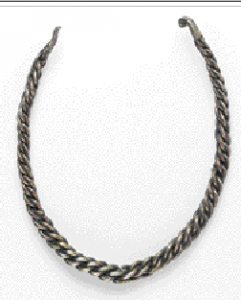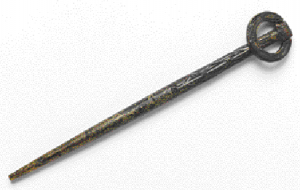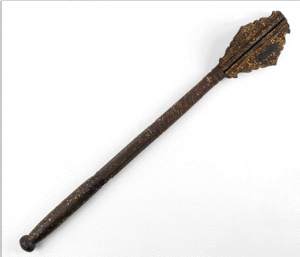Museum Eye
Published in Issue 2 (March/April 2014), Reviews, Volume 22Clontarf 1014: Brian Boru and the battle for Dublin
National Museum of Ireland
Kildare Street, Dublin 2
www.museum.ie
By Tony Canavan

A silver neck-ring from either County Clare or County Limerick. (NMI)
This major exhibition to mark the millennium of the Battle of Clontarf features artefacts, information panels, artist’s representations of the warriors involved, maps and so on. The artefacts and illustrations are divided thematically. A major theme is Brian Boru himself. There is an attempt to place him in his historical and contemporary context. Given his place in modern perceptions of Clontarf, the exhibition shows that as the first ‘true’ high-king of Ireland he was also the first to appreciate fully the military and economic potential of the Vikings. His exploitation of Viking Limerick helped him to achieve power in Munster, and ultimately it was his control of Dublin and its resources that enabled him to become high-king. Far from wanting to expel the Vikings, he wanted them to remain in Ireland but under his control.
![The Liathmore shrine fragment—the inscription reads: ‘…[MA]C CENEDIC DO RIG E[RINN]…’ (‘son of Cenétig, for the king of Ire[land]’). This can only refer to Brian Boru, who may have commissioned the reliquary. (NMI)](https://www.historyireland.com/wp-content/uploads/2014/03/51-300x79.png)
The Liathmore shrine fragment—the inscription reads: ‘…[MA]C CENEDIC DO RIG E[RINN]…’ (‘son of Cenétig, for the king of Ire[land]’). This can only refer to Brian Boru, who may have commissioned the reliquary. (NMI)

The only object directly associated with Clontarf is this intricately decorated ringed pin, used to fasten a cloak or tunic. (NMI)
Presenting the battle itself is a problem, as no artefacts can be directly associated with it. In fact, the site was probably stripped of anything useful or valuable within days of the event, so that should not be a surprise. This section, however, explains who was involved—it was not all Irish on one side against the ‘invaders’ on the other—and what they were armed with. Some objects here are of real importance. The Banagher sword, discovered by divers in the River Shannon, is a well-preserved Viking sword, dated to the tenth century. Given that swords were used for decades, it may well have armed one of the Viking warriors of Brian Boru’s Limerick fleet. It was lost while still in its scabbard and the remains of this cling to the blade, giving archaeologists a unique insight into its construction. Fragments of the grip on the handle also survive, indicating that it was bound with a strip of cloth rather than leather or wire, as is usually supposed. Recently discovered axeheads will be on display for the first time. Found in a sunken dugout canoe in Lough Corrib, the three axeheads still have their wooden shafts. Dating from the Clontarf era or a little later, these are undoubtedly Irish weapons, although Viking in style and manufacturing technique. They presented quite a problem to the conservators but illustrate that Irish and Viking warriors were armed in a similar manner by this time.

A Crucifixion plaque, probably from Killaloe. (NMI)
The only object directly associated with Clontarf is an intricately decorated ringed pin, used to fasten a cloak or tunic. It dates from the same period as the battle but there is no proof directly connecting the pin to it. A curious object on display is a small representation of a bird discovered at Clontarf in the nineteenth century. Described in the nineteenth century as a raven, presumably because this bird was sacred to the Vikings, it looks more like a pigeon and probably dates from a later period. It does, however, represent the power of the Clontarf myth.
The Viking king of Dublin in 1014, Sitric, was also its first Christian king, and a small piece of polished porphyry, excavated from Fishamble Street, is a link to him. Originating in ancient Greece, polished tiles of this stone decorated buildings in Rome. In the medieval period, pilgrims to Rome often took pieces of these tiles home as souvenirs. We know that Sitric, who survived Clontarf, made a pilgrimage to Rome and he may have taken such a piece of porphyry home to Dublin as a memento.

Another object mistakenly associated with Brian Boru is his ‘sceptre’—in fact a fifteenth-century German mace. How it ended up with the O’Brien family and became associated with Brian Boru is a mystery. (NMI)
The exhibition concludes with sections on the aftermath of the battle and its place in history. In some ways this is the most interesting part, as it engages with the myth of Brian Boru. As the centuries passed, Clontarf was represented as a decisive struggle to end the Viking invasion of Ireland and Brian not just as a national hero but also as the archetypal high-king. Objects came to be associated with him, which in turn became national symbols. The most famous is the harp housed in Trinity College’s Old Library, the origin not just of the Guinness harp (in reverse) but also of the official seal of the Irish state. Another object mistakenly associated with him is in the exhibition: his ‘sceptre’. This exquisite piece of craftsmanship is not in fact a sceptre but a fifteenth-century German mace. How it ended up with the O’Brien family and became associated with Brian Boru is a mystery. Strangest of all is a stone axehead with an engraving of Brian Boru on it. Although from the Neolithic age, it was uncovered with many others at Killaloe during the Shannon hydroelectric scheme. Brian Boru was presumably carved on it by one of the workmen!
There is further information on the museum’s website, along with videos on medieval Ireland, the Vikings and the battle, and an associated educational programme has been organised. This fascinating exhibition commemorates the Battle of Clontarf in a fitting fashion. It manages not just to present the complexities of Brian Boru as high-king and of the battle but also to display a range of artefacts associated with both in an intriguing and entertaining fashion.
Tony Canavan is editor of Books Ireland.
















